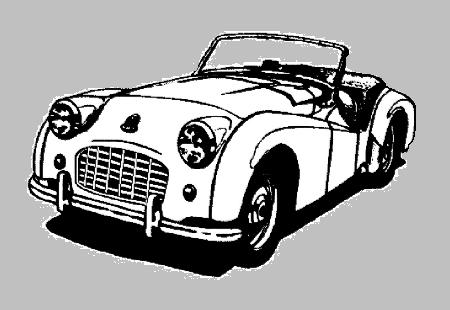
 Rear
Crankshaft Seal Conversion
Rear
Crankshaft Seal Conversion
|
Macy's Garage, Ltd. America's BEST Triumph Shop! |
We know all the jokes about British cars and oil leaks, and we laugh it off as part of the charm. It's supposed to be part of the factory rust prevention system, (obviously designed in part by Lucas, because it didn't always work!), and there's nothing you can do about it because they all leak.
Well maybe we can't stop it completely, but we can seal the worst of the offenders. I'm referring to the rear crankshaft "seal", or that pitiful excuse for one that came in our 4 cylinder TR's.
Times have certainly changed from when our charming little Triumphs were first designed. Oil was cheap and paved driveways were rare, and if you were fortunate enough to have a carriage house or shed to park your TR under roof, chances were that it had a dirt floor rather than something concrete or painted with a high gloss coating. Oil leaks were nothing to get all worked up about as long as you didn't empty the sump on the short drive to the store! Take a look at the TR3 owner's handbook, and you'll see that checking the oil level and "topping up" were recommended every 250 miles! Today, our TR's are pampered and kept clean, parked on concrete driveways and fancy garage floors, and the oil leaks which were once accepted as routine are now a much larger annoyance, and something must be done about it!
The hardest leak to stop, and probably the biggest offender of the lot is the rear crankshaft "seal". It's not really a seal at all, but a series of grooves in both the crankshaft and the seal assembly, and it's supposed to guide the oil back into the sump through the rotation of the crankshaft. The seal assembly doesn't touch the crankshaft, so there's really no sealing action taking place, and once the engine is stopped and the crankshaft is no longer spinning, the oil is free to run right out the back and start marking its' territory! Some oil is expected to get through even when the engine is running, and a drain tube is provided behind the seal to provide a return path back to the sump.
Thankfully, a rear seal conversion kit has been designed which will seal this problem spot with a modern neoprene seal, but it requires the crankshaft to be removed from the engine block and some precision work to be done by a competent machinist. It's a modification that I highly recommend doing whenever your engine is apart for an overhaul or whenever you have an opportunity to remove the crankshaft.
The following photos will demonstrate the installation of these seal conversion kits, and it's not as scary as it sounds. Follow along as we solve possibly the largest and most difficult of the TR oil leaks, but don't worry that your TR will lose any of it's charm. There are still plenty of places left for it to leak oil!
|
|
|
| Here you see the rear of a TR3 crankshaft, and the oil "scroll" at the rear that must be removed by a machinist. You can see the grooves in both the scroll and the original seal, which are supposed to direct the oil back into the pan. | In this photo, you can see that the scroll has been machined off of the crankshaft to the dimensions supplied with the conversion kit. Also note the new seal conversion kit, which resembles the original but is designed to hold the modern neoprene seal in contact with the crank. |
|
|
|
| In this photo, we see the rear main bearing cap, and the original drain tube for the oil to run back into the sump. The Moss kit calls for two additional holes to be drilled in the cap to relieve pressure against the seal, and to provide additional oil return paths. | I always drill these holes myself using a drill press, and blocking the cap so that my drill bit is parallel to the original drain tube. I like to start with a small drill bit and increase the size in a couple of steps. Don't try this with a hand held drill! |
|
|
|
| Here's the rear main cap with the two additional holes complete. The instructions called for 3/8" holes, but that's a lot of metal to remove so I always stop at 5/16". The kits we now use do not call for these holes. (See note #1 below.) | I always use a Dremel grinder and small stone to remove all the burrs and flashing around the inside of the holes, as shown on the center and right holes of this photo. |
|
|
|
| After lightly filing any burrs or rough edges of the new seal holder, apply gasket sealer to the areas indicated in the kit instructions. I like to use non-hardening Permatex #2 here. This is not a place to use silicone! | With the seal holders prepped, install the neoprene seal around the rear crankshaft journal. Apply a little light oil to the seal and the crankshaft for lubrication, and be sure that the deep channel in the seal points toward the front of the crankshaft as shown. The split in the seal will be positioned later to be "UP" toward the top of the engine. |
|
|
|
| A small spring is installed into the deep channel seen in the previous photo. The two ends of the spring have small hooks to join the ends, and the spring will hold the seal against the crankshaft as it eventually wears. | With the main bearing shells in place, and the upper half of the seal holder bolted loosely to the block, gently install the crankshaft into the block. Carefully guide the seal into the seal holder, and be sure to have the split in the seal pointing to the top of the motor (which is down toward the floor with the block upside-down on the engine stand). |
|
|
|
| These grooves along both sides of the rear main bearing cap are a good place for oil to seep through, and need to be tightly sealed. When bolting the lower half of the seal holder to the bearing cap, note that one bolt hole on each side extends into the grooves. I leave these two bolts loose for now, to be certain that I can press the felt seals all the way to the bottom. | Gasket sets usually come with only one piece of this rear cap seal. Buy a second because one will not be enough to totally seal these grooves. Cut both pieces into little pieces about 1" in length. |
|
|
Congratulations! The seal conversion is complete! You've just taken a giant step toward dispelling the British Car's reputation for leaking oil! This really is something you'll want to do if you ever have the chance, and the environment and your garage floor will thank you for it! |
|
With the rear main cap torqued in place, I dip the small cap seal pieces in Aviation Permatex an push them to the bottom of the grooves with a long thin screwdriver. Pack the pieces in tightly one after another until the entire groove is completely filled. Note the loose bolt below the tweezers in this photo. This is the one that I left loose until after the groove has been filled with the seal pieces. Don't forget to tap the two seal holders together and tighten all the bolts when you're done. |
|
|
NOTE 1: We're now using seal conversion kits exclusively from Revington TR in the UK after difficulties with a couple of kits from USA suppliers. You'll have to order these from England if you want to be assured of using the best possible parts.
|
NOTE 2: We have recently discovered (the hard way) that the new aluminum seal holders are slightly thicker than the original scroll seal. Normally this isn't a problem, but we did have one instance where the flywheel bolts had stretched slightly, and they extended fully through the rear of the crankshaft hub and dug into the seal holder, just enough to keep the engine from turning over. Either use new flywheel bolts or try to rotate your crankshaft immediately after installing the flywheel to check this!
|











